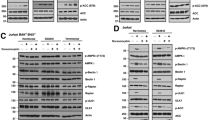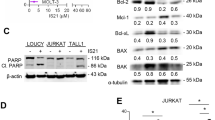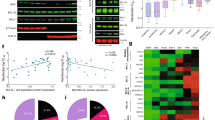Abstract
Small molecule tyrosine kinase inhibitors, such as imatinib, are effective therapies for BCR-ABL-mediated human leukemias. However, clinical drug resistance occurs, which warrants development of alternative and/or complementary therapeutic strategies to target critical downstream signaling molecules. We recently demonstrated that disrupting 14-3-3/ligand association by a peptide-based 14-3-3 competitive antagonist R18 induces significant apoptosis, partially through reactivation of AKT-inhibited proapoptotic FOXO3a, in FGFR1 fusion-transformed hematopoietic cells. Here, we report that targeting 14-3-3 by R18 effectively induced significant apoptosis in Ba/F3 and K562 cells expressing BCR-ABL, similarly through liberation and reactivation of FOXO3a. Moreover, R18 sensitized BCR-ABL-transformed cells to inhibition with MEK1 inhibitor U0126, Bcl-2 inhibitor GX15-070, or mTOR inhibitor rapamycin. Treatment with these reagents potentiated R18-induced reactivation of proapoptotic FOXO3a with enhanced expression of downstream transcription targets p27kip1 and Bim1. Furthermore, R18-induced apoptotic cell death in cells expressing diverse imatinib-resistant BCR-ABL mutants, including T315I. This inhibition was enhanced by R18 in combination with U0126 and rapamycin. Thus, our findings suggest that targeting 14-3-3 may potentiate the effects of conventional therapy for BCR-ABL-associated hematopoietic malignancies, and overcome drug resistance.
This is a preview of subscription content, access via your institution
Access options
Subscribe to this journal
Receive 12 print issues and online access
$259.00 per year
only $21.58 per issue
Buy this article
- Purchase on Springer Link
- Instant access to full article PDF
Prices may be subject to local taxes which are calculated during checkout





Similar content being viewed by others
References
Gilliland DG, Jordan CT, Felix CA . The molecular basis of leukemia. Hematology (Am Soc Hematol Educ Program) 2004, 80–97.
Shah NP, Nicoll JM, Nagar B, Gorre ME, Paquette RL, Kuriyan J et al. Multiple BCR-ABL kinase domain mutations confer polyclonal resistance to the tyrosine kinase inhibitor imatinib (STI571) in chronic phase and blast crisis chronic myeloid leukemia. Cancer Cell 2002; 2: 117–125.
Azam M, Latek RR, Daley GQ . Mechanisms of autoinhibition and STI-571/imatinib resistance revealed by mutagenesis of BCR-ABL. Cell 2003; 112: 831–843.
Weisberg E, Manley PW, Breitenstein W, Bruggen J, Cowan-Jacob SW, Ray A et al. Characterization of AMN107, a selective inhibitor of native and mutant Bcr-Abl. Cancer Cell 2005; 7: 129–141.
Kimura S, Ashihara E, Maekawa T . New tyrosine kinase inhibitors in the treatment of chronic myeloid leukemia. Curr Pharm Biotechnol 2006; 7: 371–379.
Steelman LS, Pohnert SC, Shelton JG, Franklin RA, Bertrand FE, McCubrey JA . JAK/STAT, Raf/MEK/ERK, PI3K/Akt and BCR-ABL in cell cycle progression and leukemogenesis. Leukemia 2004; 18: 189–218.
Kawauchi K, Ogasawara T, Yasuyama M, Ohkawa S . Involvement of Akt kinase in the action of STI571 on chronic myelogenous leukemia cells. Blood Cells Mol Dis 2003; 31: 11–17.
Sattler M, Mohi MG, Pride YB, Quinnan LR, Malouf NA, Podar K et al. Critical role for Gab2 in transformation by BCR/ABL. Cancer Cell 2002; 1: 479–492.
Xiao S, Nalabolu SR, Aster JC, Ma J, Abruzzo L, Jaffe ES et al. FGFR1 is fused with a novel zinc-finger gene, ZNF198, in the t(8;13) leukaemia/lymphoma syndrome. Nat Genet 1998; 18: 84–87.
Dong S, Kang K, Gu T, Kardar S, Fu H, Lonial S et al. 14-3-3 integrates pro-survival signals mediated by the AKT and MAPK pathways in ZNF198-FGFR1 transformed hematopoietic cells. Blood 2007; 110: 360–369.
Perez-Galan P, Roue G, Villamor N, Campo E, Colomer D . The BH3-mimetic GX15-070 synergizes with bortezomib in mantle cell lymphoma by enhancing Noxa-mediated activation of Bak. Blood 2007; 109: 4441–4449.
Chen J, Williams IR, Lee BH, Duclos N, Huntly BJ, Donoghue DJ et al. Constitutively activated FGFR3 mutants signal through PLCgamma-dependent and -independent pathways for hematopoietic transformation. Blood 2005; 106: 328–337.
Fu H, Subramanian RR, Masters SC . 14-3-3 proteins: structure, function, and regulation. Annu Rev Pharmacol Toxicol 2000; 40: 617–647.
Porter GW, Khuri FR, Fu H . Dynamic 14-3-3/client protein interactions integrate survival and apoptotic pathways. Semin Cancer Biol 2006; 16: 193–202.
Reuther GW, Fu H, Cripe LD, Collier RJ, Pendergast AM . Association of the protein kinases c-Bcr and Bcr-Abl with proteins of the 14-3-3 family. Science 1994; 266: 129–133.
Acknowledgements
This work was supported in part by NIH grant CA120272 (J Chen), the Leukemia and Lymphoma Society (J Chen) and the Golfer Against Cancer Foundation (J Chen and S Lonial). J Chen is a Georgia Cancer Coalition Distinguished Cancer Scholar.
Author information
Authors and Affiliations
Corresponding author
Additional information
Supplementary Information accompanies the paper on the Leukemia website (http://www.nature.com/leu)
Supplementary information
Rights and permissions
About this article
Cite this article
Dong, S., Kang, S., Lonial, S. et al. Targeting 14-3-3 sensitizes native and mutant BCR-ABL to inhibition with U0126, rapamycin and Bcl-2 inhibitor GX15-070. Leukemia 22, 572–577 (2008). https://doi.org/10.1038/sj.leu.2405064
Received:
Revised:
Accepted:
Published:
Issue Date:
DOI: https://doi.org/10.1038/sj.leu.2405064
Keywords
This article is cited by
-
The dynamic and stress-adaptive signaling hub of 14-3-3: emerging mechanisms of regulation and context-dependent protein–protein interactions
Oncogene (2018)
-
Inhibition of Ras-mediated signaling pathways in CML stem cells
Cellular Oncology (2015)
-
Targeting 14-3-3zeta in cancer therapy
Cancer Gene Therapy (2012)
-
Targeting survival cascades induced by activation of Ras/Raf/MEK/ERK, PI3K/PTEN/Akt/mTOR and Jak/STAT pathways for effective leukemia therapy
Leukemia (2008)
-
BCL-2 family antagonists for cancer therapy
Nature Reviews Drug Discovery (2008)



